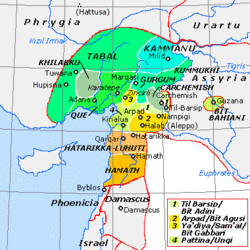Carchemish
| Viceroyalty of Carchemish / Kingdom of Carchemish | ||||||||||
| Karkamiša | ||||||||||
|
||||||||||
|
Carchemish among the Neo-Hittite states
|
||||||||||
| Capital | Carchemish | |||||||||
| Languages | Hittite, Hieroglyphic Luwian | |||||||||
| Religion | Hittite-Luwian religion | |||||||||
| Government | Monarchy | |||||||||
| Historical era | Bronze Age, Iron Age | |||||||||
| • | Established | c. 1321 BC | ||||||||
| • | Disestablished | 717 BC | ||||||||
|
||||||||||
| Today part of |
|
|||||||||
Carchemish (/kɑːrˈkɛm.ɪʃ/ kar-KEM-ish), also spelled Karkemish (Hittite: Karkamiš;Turkish: Karkamış; Greek: Εὔρωπος; Latin: Europus), was an important ancient capital in the northern part of the region of Syria. At times during its history the city was independent, but it was also part of the Mitanni, Hittite and Neo-Assyrian Empires. Today it is on the frontier between Turkey and Syria.
It was the location of an important battle, about 605 BC, between the Babylonians and Egyptians, mentioned in the Bible (Jer. 46:2). Modern neighbouring cities are Karkamış in Turkey and Jarabulus in Syria (also Djerablus, Jerablus, Jarablos, Jarâblos) [6]; the original form of the modern toponym seems to have been Djerabis or Jerabis, likely derived from Europos, the ancient name of the Hellenistic-Roman settlement.
Coordinates: 36°49′47″N 38°00′54″E / 36.82972°N 38.01500°E
...
Wikipedia

